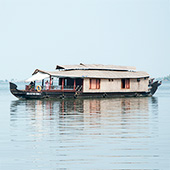Design Resource
Traditional Vanji Making - Alleppey, Kerala
Boat Making
by
Prof. Bibhudutta Baral and Ranjitha M. C.
Alleppey still follows a tradition of making traditional Vanji (boat) making. Traditional boat making is classified into two categories: one is stitched and the other is built with nailed planks. The traditional boat construction starts with the laying of a keel, which is the foundation beam for the wooden boat. Enormous wooden pieces are supported on a branching stern above the ground at both ends. This is paced to take the stern-post and stem-post, all made of massive pieces of wood. Initially, wooden logs are arranged vertically on the ground according to the required size and the shape of the boat to give external support to build a boat. Then the keel is laid on the wooden logs and then the planks are attached by hammering the copper nails. Usually, a single piece of wood is preferred for the keel and stern.
The planks are clasped horizontally on either side of the keel to make a perfect frame to build a boat. Then the bending process is mainly based on the traditional method of applying neem oil on planks and mildly heating to obtain the curvature of the boat. Then the wooden planks are added for renovation and nailed temporarily and stitched together using synthetic rope by drilling holes at the edges of the planks. The coconut fibre strands are bundled (twelve strips) and inserted into the coir. Then the bundles are stitched along with the coir in a vertical and cross-stitch method with the help of a needle. The coir is pulled by winding the coir strip to the hammer to tighten the stitch and the small gaps are filled with the coir. Once done with the stitching, fish oil is applied to the boat and then coloured according to the design.

















